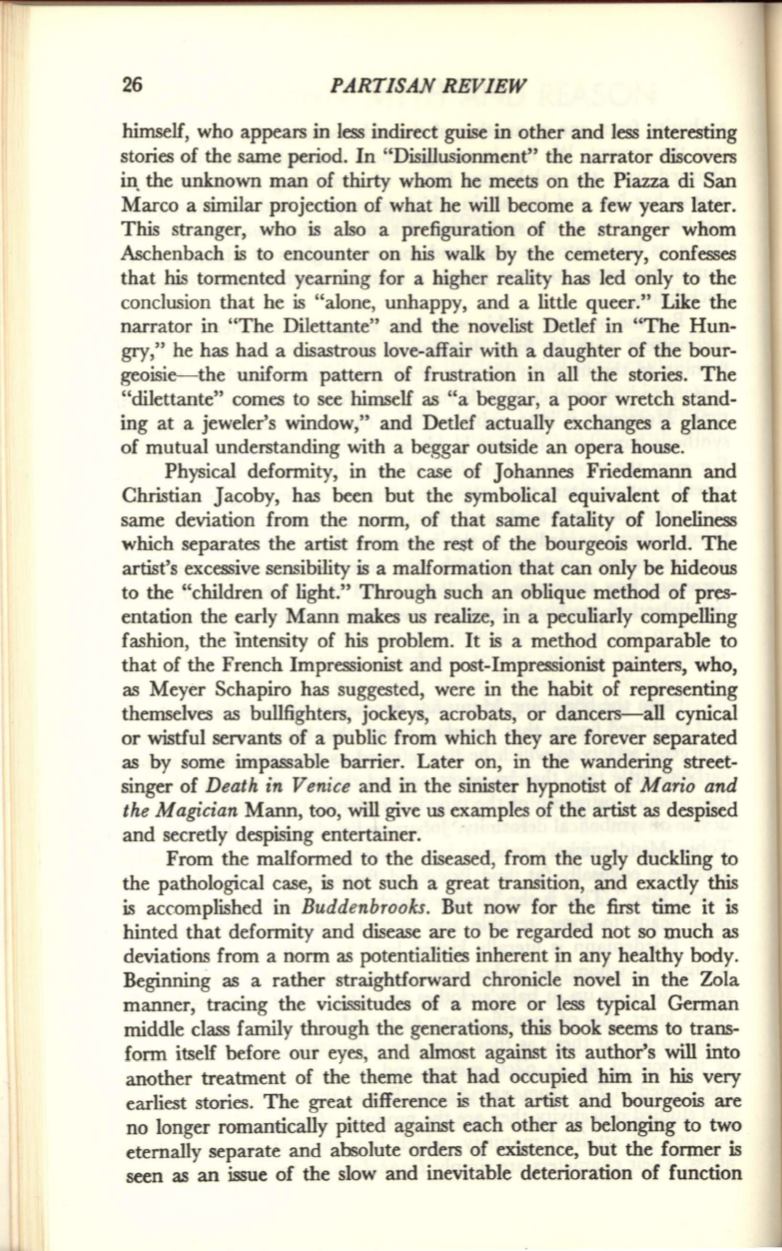
26
PARTISAN REVIEW
himself, who appears in less indirect guise in other and less interesting
stories of the same period. In "Disillusionment" the narrator discovers
in. the unknown man of thirty whom he meets on the Piazza
di
San
Marco a similar projection of what he will become a few years later.
This stranger, who is also a prefiguration of the stranger whom
Aschenbach is to encounter on his walk by the cemetery, confesses
that his tormented yearning for a higher reality has led only to the
conclusion that he is "alone, unhappy, and a little queer." Like the
narrator in "The Dilettante" and the novelist DetIef in "The Hun–
gry," he has had a disastrous love-affair with a daughter of the bour–
geoisie-the uniform pattern of frustration in all the stories. The
"dilettante" comes to see himself as "a beggar, a poor wretch stand–
ing at a jeweler's window," and Detlef actually exchanges a glance
of mutual understanding with a beggar outside an opera house.
Physical deformity, in the case of Johannes Friedemann and
Christian Jacoby, has been but the symbolical equivalent of that
same deviation from the norm, of that same fatality of loneliness
which separates the artist from the rest of the bourgeois world. The
artist's excessive sensibility is a malformation that can only be hideous
to the "children of light." Through such an oblique method of pres–
entation the early Mann makes us realize, in a peculiarly compelling
fashion, the intensity of his problem. It is a method comparable to
that of the French Impressionist and post-Impressionist painters, who,
as Meyer Schapiro has suggested, were in the habit of representing
themselves as bullfighters, jockeys, acrobats, or dancers-all cynical
or wistful servants of a public from which they are forever separated
as by some impassable barrier. Later on, in the wandering street–
singer of
Death in Venice
and in the sinister hypnotist of
Mario and
the Magician
Mann, too, will give us examples of the artist as despised
and secretly despising entertainer.
From the malformed to the diseased, from the ugly duckling to
the pathological case, is not such a great transition, and exactly
this
is accomplished in
Buddenbrooks.
But now for the first time it is
hinted that deformity and disease are to be regarded not so much as
deviations from a norm as potentialities inherent in any healthy body.
Beginning as a rather straightforward chronicle novel in the Zola
manner, tracing the vicissitudes of a more or less typical German
middle class family through the generations, this book seems to trans–
form itself before our eyes, and almost against its author's will into
another treatment of the theme that had occupied
him in
his very
earliest stories. The great difference is that artist and bourgeois are
no longer romantically pitted against each other as belonging to two
eternally separate and absolute orders of existence, but the former is
seen as an issue of the slow and inevitable deterioration of function


